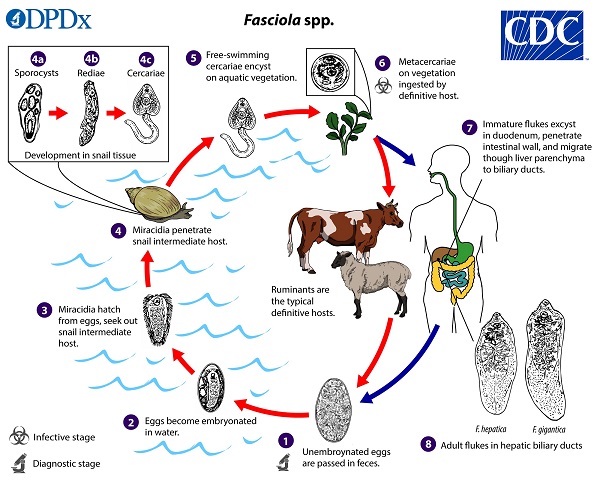Fasciola hepatica - Life Cycle, Pathogenesis, Pathology, Host Immunity
Life Cycle of Fasciola hepatica
The life cycle of Fasciola hepatica occurs in the following hosts while aquatic vegetations are also mandatory.
Definitive host: Sheep is the primary definite host while other definitive hosts include humans, goats, cattle, and other herbivores.
Intermediate host:
First intermediate host: Amphibian snails of the family Lymnaeidae while the genera of the host snails depend on the geographical region.
Secondary Intermediate host: watercress (Nasturtium officinale) and aquatic vegetations harbour the infective stage (metacercariae) of Fasciola hepatica.
the definitive host acquires infection after consumption of the secondary intermediate host - watercress (Nasturtium officinale) and aquatic vegetations harbour – harbouring the metacercariae of Fasciola hepatica
once metacercariae reach the duodenum, it excysts and penetrates the intestinal wall, and peritoneal cavity to invade the liver capsule
these larvae reach the hepatic and common bile duct after migrating through the liver parenchyma
in these ducts, the metacercariae mature into adult Fasciola hepatica
* in some cases, the larvae may travel to ectopic sites where they mature and live for years while feeding on hepatocytes and duct epithelium
after mating, they began laying unembryonated eggs
the time between infection by metacercariae and the production of eggs i.e. the pre-patent period is around 4 months
these eggs cross the sphincter of Oddi and the intestine from where they are passed along with the host faeces
once in the water, further development of Fasciola hepatica eggs takes place
within 2 to 3 weeks, the egg hatches to release one miracidium larva per egg
the miracidium larvae of the liver fluke can live for 8 hours during which it must find and invade the amphibian snails of the family Lymnaeidae – otherwise, it does
once inside its primary intermediate host, the miracidium larvae underdo asexual reproduction by a single generation of sporocysts, two generations of rediae (mother rediae and daughter rediae)
within 4 to 7 weeks, a single miracidium larva gives rise to a large number of cercariae
the Fasciola hepatica cercariae then escape from the snail into the water and adhere to the secondary intermediate host - watercress (Nasturtium officinale), water lettuce, mint, khat and aquatic vegetations
after a few hours on the second intermediate host, the cercariae encyst to form metacercariae
if the second intermediate host harbouring metacercariae is consumed, it causes liver fluke infection in the definitive host including the man – thus the life cycle of Fasciola hepatica is continued

Figure: Fasciola hepatic life-cycle (Source: CDC)
Pathogenesis, Pathology in Fasciola hepatica infection
Both the adult form and the migrating larvae of Fasciola hepatica cause pathogenic lesions/pathology in humans.
Pathogenesis of migrating larvae
when the developing liver fluke larvae migrate in the hepatic parenchyma, traumatic or necrotic lesions are induced
characteristics of acute infection
clinical syndromes caused by the migrating larvae include liver damage, inflammation of the bile duct, extensive haemorrhage, haematomas
multiple subcapsular cavities (measuring 5 to 10 mm) surrounded by inflammatory infiltrates containing a large number of eosinophils can be found
Pathogenesis of adult Fasciola hepatica
biliary obstruction symptoms are presented when the adult forms of Fasciola hepatica lodge in the gall bladder or bile duct lumen
associated with chronic infections
pathological changes include intermittent obstruction, inflammation, dilation of the biliary tract with thickening of the wall
in the gall bladder and bile duct, the liver fluke causes hyperplasia and fibrosis
in chronic cases, the bile duct has epithelial hyperplasia with minimal pericholangitis and proliferation of tissues
in sheep, liver rot occurs which is a serious illness
Host immunity in Fasciola hepatica infection
Although circulating antibodies alone do not give host immunity against Fasciola hepatica infection, they can combine with cell-mediated immunity to destroy the flukes in the liver and the bile duct.